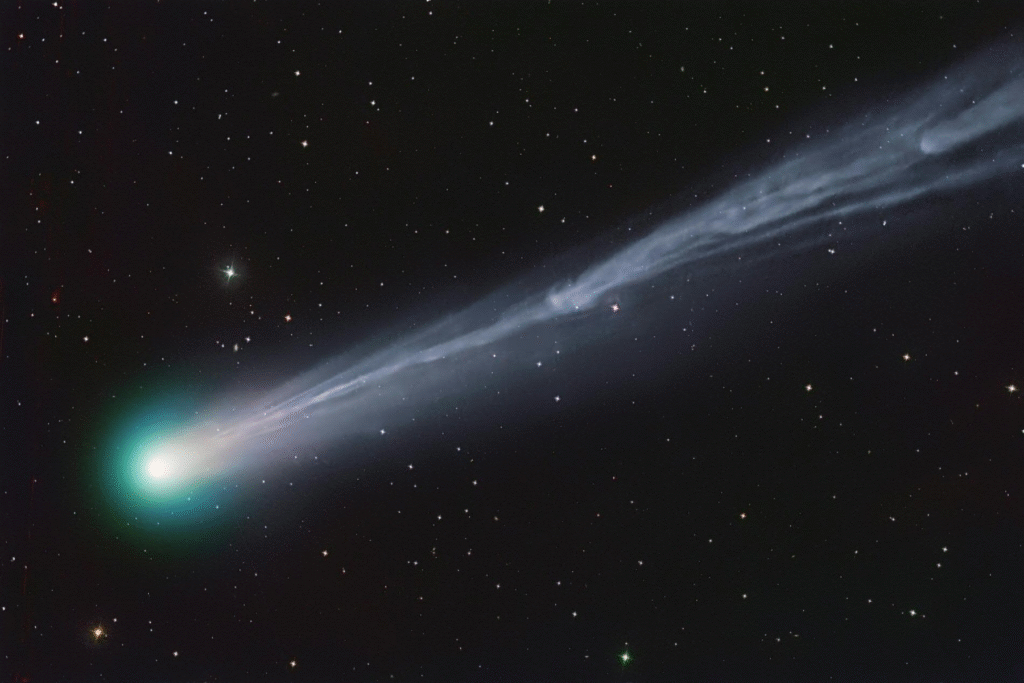
Almost exactly one year after the comet “C/2023 A3 Tsuchinshan-Atlas” offered good visibility, another bright comet is now approaching: the newly discovered comet C/2025 A6 (Lemmon) will be visible from mid-October as a prominent object through simple telescopes, and—under low light pollution, away from cities—even faintly to the naked eye, comet expert Michael Jäger told APA.
Comet C/2025 A6 (Lemmon) was discovered in images taken on January 3 of this year by the Mount Lemmon Survey (USA). It is approaching the Sun on an extremely long-period elliptical orbit and will reach its closest point to the Sun (perihelion) on November 8 at a distance of 79 million kilometers—about half the Earth’s distance from the Sun—according to Alexander Pikhard of the Vienna Working Group for Astronomy (WAA). Its closest approach to Earth will occur on October 21 at about 90 million kilometers.
Brightness Outburst In Summer
“Lemmon” experienced a brightness outburst over the summer. Its strong development was “unexpected, since initial forecasts predicted the comet would be much fainter. However, it is not the first time that the brightness of a long-period comet has evolved very dynamically,” said Jäger, chairman of the Astronomical Center Martinsberg (AZM) in the Waldviertel region of Lower Austria.
At the beginning of October, the comet reached magnitude 6—a measure of apparent brightness—placing it at the threshold of visibility to the naked eye, at least under dark mountain skies. “Current brightness estimates under moonlight show that the upward trend continues, and we can expect an object of magnitude 4 within a few days,” Jäger said. The best viewing period will be between October 20 and 26, when the comet will stand about 20 degrees high in the sky at the end of dusk and should shine at magnitude 3.
Comet “Swan” Only Visible Through Telescope
According to experts, this brightness should be sufficient to see the comet with the naked eye in areas with low light pollution, though binoculars are recommended for clearer observation. According to the Astronomical Working Group Salzkammergut (AAS), “Lemmon” will appear below the constellation Ursa Major (the Big Dipper), low in the northwest around 7:30 p.m., or better yet—higher above the horizon—between 4:00 and 5:00 a.m. in the northeast. By late October, the comet will move through the constellation Serpens in the west. After October 26, moonlight will increasingly interfere, and the comet will gradually sink toward the horizon. Visibility will end around November 10, Jäger said.
October even offers a second comet: C/2025 R2 (Swan), though it is “mainly for specialists,” Jäger noted. The comet will move low across the evening sky through the summer Milky Way until mid-October and is visible only through a telescope. As it moves farther from the Sun, it will appear increasingly diffuse.
Dirty Snowballs
Comets are considered remnants from the formation of our solar system about 4.6 billion years ago. They are composed of a mixture of ice, dust, and rock and are often compared to “dirty snowballs.” The ice contains not only frozen water but also carbon dioxide, methane, and ammonia. Many comets move in highly elliptical orbits through the solar system: they emerge from its outer regions and come close to the Sun, where they warm up and form their often spectacular tails.
As they heat up, a large cloud of gas and dust forms around the small comet nucleus, known as the coma. The “solar wind,” a steady stream of particles emitted by the Sun, blows this gas-and-dust mixture away from the comet, forming a tail that always points away from the Sun.

